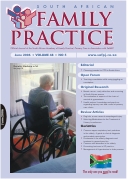The evaluation of aspects of the chain of survival at gymnasiums in the Pretoria area
Abstract
Background Sudden cardiac death related to exercise is an uncommon problem, but is perhaps the single biggest challenge to sports medicine practitioners. Although the overall risk of death due to cardiac causes is substantially reduced in those who exercise regularly, the risk is temporarily increased during exercise. The causes of sudden cardiac death related to exercise vary according to age and are divided into two groups. Firstly, those under 35 years, where structural abnormalities of the heart pose a risk. The most common congenital abnormality is hypertrophic cardiomyopathy (HOCM), which occurs in up to two per 1 000 births. Secondly, those above 35 years, where coronary artery disease is the leading cause of sudden cardiac deaths. The most frequent initial rhythm documented in witnessed cardiac arrest is ventricular fibrillation (VF). The most effective treatment for VF is defibrillation. The probability of successful defibrillation decreases by approximately seven to 10 percent for every minute that defibrillation is delayed. VF tends to convert to asystole within a few minutes if left untreated. No matter what the setting – home, community or hospital – the majority of successful adult resuscitations depend on early defibrillation.5 Public education and training are crucial aspects of any effort to reduce cardiac death. Because the majority of sudden cardiac deaths occur outside the hospital, it is clear that the community must be recognised as the ‘ultimate coronary care unit’. Communities with a high number of lay persons trained in life-saving techniques such as cardiopulmonary resuscitation (CPR) and the use of automated external defibrillators (AEDs) may achieve resuscitation rates as high as 49% for patients with a documented out-of-hospital VF. CPR is a critical component of BLS (basic life support). Prompt bystander CPR is crucial to all resuscitation efforts. In the absence of prompt bystander CPR, successful resuscitation of out-of-hospital cardiac arrest victims is unlikely, despite the availability of trained paramedics with a rapid response time. CPR performed while waiting for defibrillation appears to prolong VF and contribute to the preservation of heart and brain function. The purpose of the study was to evaluate aspects of the chain of survival in gymnasiums in the Pretoria area. This chain of survival was evaluated against the Basic Life Support (BLS) system known in cardiac resuscitation. Methods Twelve gymnasiums in the Pretoria area were included in the study. A structured questionnaire was given to a staff member of each gymnasium after explanation of the purpose of the study. Results Of the gymnasiums visited, 83% had emergency telephone numbers at hand, while 100% of the staff had CPR training (75% in the last year). Half of the gymnasiums visited had automated external defibrillators (AEDs) available and the staff members at the respective gymnasiums had been trained in the use thereof. Conclusion The partaking gymnasiums in the Pretoria area are well prepared for cardiac emergencies. It is recommended that fitness instructors, medical practitioners and the general public working out in gymnasiums be familiar with the chain of survival, especially how to operate an AED.
Issue
Section
Original Research
By submitting manuscripts to SAFP, authors of original articles are assigning copyright to the South African Academy of Family Physicians. Copyright of review articles are assigned to the Publisher, Medpharm Publications (Pty) Ltd, unless otherwise specified. Authors may use their own work after publication without written permission, provided they acknowledge the original source. Individuals and academic institutions may freely copy and distribute articles published in SAFP for educational and research purposes without obtaining permission.

